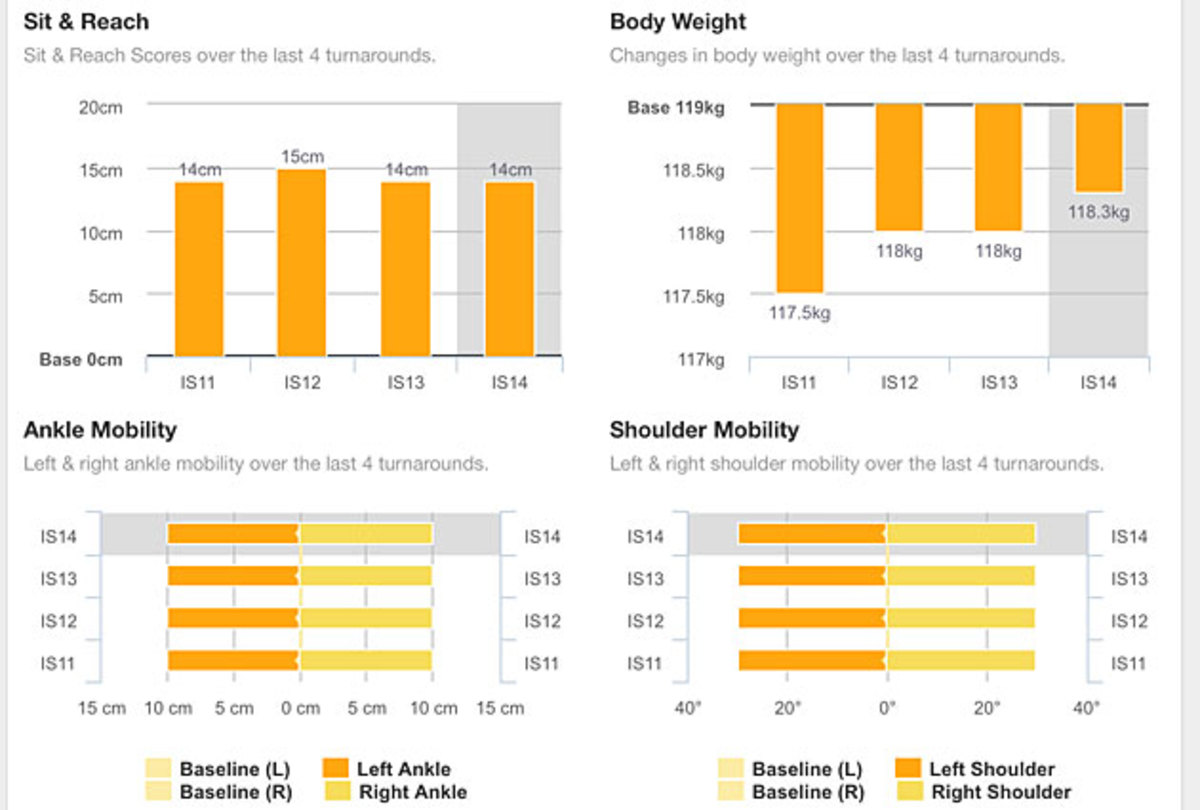Dodgers among teams hoping new system can help prevent injuries

Analytics are mainstream in baseball. They have changed the way we look at the game, whether from finding hidden value in past performance (the way of Moneyball), debunking the wisdom of conventional strategy (the rate of sacrifice bunts is at an all-time low) or recently becoming a predictive strategic tool (the rise of defensive shifts). But what if analytics could prevent injuries? As performance analytics have become conventional, is biometric health the next frontier for clubs to gain an edge?
Imagine if three times per week every player on the team walked himself through seven or eight range-of-motion testing stations (shoulders, elbows, ankles, etc.)—all in front of a motion-capture camera, so there are no wires, electrodes or elaborate hardware. All the information is continually collected and monitored. Now imagine an app, with a dashboard-style presentation, that can alert the player and club about any changes in baseline levels of strength or range of motion—like a bank app alerting you when your balance is low.
Now also imagine that the strength training coach takes all of the players’ workout data—which used to be collected in its own “silo”—and inputs that into the same system. And now imagine that all the data collected about pitchers’ workload—every time a pitcher throws, be it in a game, warming up without getting in a game, or a side session; more info that also had been kept in its own “silo”—also gets dumped into the same system.
Sports Illustrated's 2015 MLB season preview rankings
In a perfect world, you would have a system that could provide real data to coaching and training staffs to anticipate injuries or downturns in performance, not just relying on someone to decide, “he looks tired” or “his bat looks slow.” That’s the idea behind The Profiler, a system designed by Kitman Labs, an Irish sports technology company. It has been used by Irish rugby teams and now is being adapted for major league baseball teams. The Los Angeles Dodgers have signed on to use The Profiler, with at least two other clubs, including the San Francisco Giants, expected to follow.
If you’re imagining an app that will tell Clayton Kershaw to miss two starts in July because of a five percent decline in shoulder range of motion, forget it.
“No, no, no,” said Dodgers vice president of medical services Stan Conte. “At the end of the day, it’s not the data, it’s the analyst that makes the decision. Analytics usually confirm what you’re seeing, anyway. It’ll never be the computer that makes the difference. Everybody is measuring everything now. OK, now what are we going to do with it? If you don’t know, there’s no reason to collect it.”
"The idea," continued Conte, "is that you set these marks and if a player is having an issue with a lack of motion or lack of strength—and we know that because we can measure it two or three times per week—the program will alert you that this guy is declining in this area, and maybe you should take a look at him. We always talk about players who don’t tell you when they’re hurt, or they don’t know the difference between pain and an injury. Well, if we have the right system biometrics can tell us there is a slight decline before he gets injured.”
The Dodgers are not using The Profiler on their major league players this year because they chose not to participate. They are using it only with their minor league players.
“We tested it with players in spring training and on the major league level we got zero compliance,” Conte said. “In the minors it was 95 percent compliance.”

Conte has been working with Kitman for about a year to help fit The Profiler for baseball. One of his initial concerns was how time-consuming the collection and input of data would be, but each monitoring “station” can be completed in as little as 10 to 15 seconds.
"One of the things that interested me is how their predictive software works,” Conte said. “In the past five years there has been a lot of new predicative software in the field of analytics, where the system learns the data and questions itself. That’s what drove me to do research on them.
"One of the problems with baseball is not in the collecting of data but in the analyzing of it. Every team looks at a lot of biometrics. Range of motion is a big thing—whether pitchers have restrictions and whether that can be predictive. A lot of teams will do this in the beginning of the season and at the end of the season. So it makes a lot of sense to me that we be doing it throughout the season.
As the analytics in baseball grow, it would be easy to assume that cold-hearted data is taking over the game. Instead, the rise of information is putting a greater value on the analysts—the people who can interpret the data in smart, functional ways.
"The first thing we want to find out is, does the software do what it says it’s going to do?" Conte said. "I like what the software appears to give you. I think it’s worth the effort to try it. We’ve been pretty happy with the company and what they said about baseball versus rugby or soccer. At the end of the day will it work? We have to see if that’s the case. It’s a fascinating program and it intrigued me to work on it."
